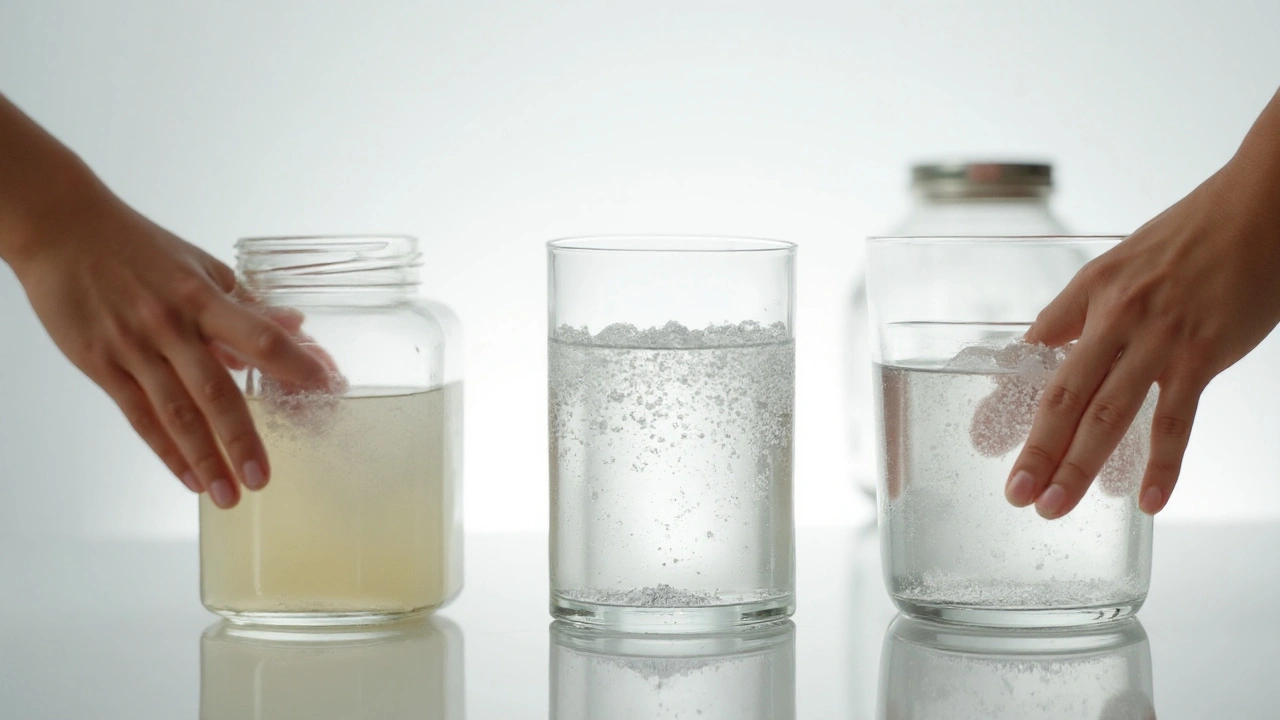A fiber that disappears into your coffee and doesn’t leave you bloated sounds like a scam. It isn’t. That’s acacia, also called gum arabic-one of the easiest ways to nudge your gut, appetite, and metabolic markers in the right direction. It won’t fix a fast-food diet or poor sleep, but if you need a simple, low-drama prebiotic you can actually stick with, this is worth a look.
TL;DR:
- Acacia (gum arabic) is a gentle, well-tolerated prebiotic fiber that mixes clear and tastes neutral.
- It’s linked to better gut comfort, more regularity, and modest support for cholesterol and appetite control.
- Compared with inulin or FOS, it tends to cause less gas; compared with psyllium, it’s lighter but not as strong for constipation.
- Start with 3-5 g/day, build to 10-15 g/day; separate from meds by ~2 hours; go slow if you’re sensitive.
- Buy 100% Acacia senegal powder, third‑party tested, no sweeteners, and aim for an honest cost per 10 g serving.
Top reasons to try acacia now (and how to choose a product you’ll actually use)
If you clicked looking for “top reasons,” here they are-straight and simple. I’ll also show you how to pick the right product so you don’t waste time or cash.
Quick primer: acacia (aka gum arabic) is a soluble, fermentable fiber tapped from Acacia senegal or Acacia seyal trees. It dissolves clear, barely changes texture, and has a clean, non-sweet taste. That makes it unusually easy to use daily-no gritty sludge, no weird aftertaste.
acacia supplement
- Gentle on sensitive guts. Unlike inulin or chicory root fiber-which often cause gas-acacia ferments more slowly. In a controlled trial (Calame et al., British Journal of Nutrition, 2008), participants tolerated up to 30 g/day with minimal GI complaints while bifidobacteria levels rose. If you’ve quit other fibers because of bloat, acacia is a friendlier on‑ramp.
- Steadier regularity without the rush. It softens and forms stool, but it’s not a trigger-happy laxative. Many people notice smoother bathroom habits in 3-7 days. For chronic constipation, psyllium is usually stronger; for daily comfort, acacia often feels calmer.
- Prebiotic support for the microbiome. Multiple human studies show increases in beneficial gut species (Bifidobacterium, Lactobacillus) with acacia intake (Calame 2008; Cherbut et al., 2003). Better fermentation often means better short‑chain fatty acid production-fuel for your gut lining.
- Modest metabolic perks. Soluble fibers can help with LDL cholesterol and post‑meal glucose. Trials using gum arabic have reported small reductions in LDL when taken consistently for several weeks, especially when displacing refined carbs (e.g., Anderson et al., American Journal of Clinical Nutrition, late 1990s; Alginate/arabic gum composites have similar trends). Set expectations: think “nudge,” not “stat-drug.”
- Appetite help you can feel. In a randomized trial in women (Nutrition Journal, 2012), gum arabic intake was associated with reduced body fat and improved satiety signals. It won’t erase willpower, but it can make staying full between meals less of a fight.
- Easy to stay consistent. Because it disappears into water, coffee, or smoothies, compliance is higher. Consistency beats mega-doses that you abandon after two days of bloat.
Is it the right fiber for you? Here’s how to decide and what to buy.
Decision criteria when choosing acacia in 2025:
- Species: Look for Acacia senegal (often finer, cleaner taste). Acacia seyal is fine, but senegal is the gold standard in supplements.
- Purity: 100% gum arabic powder. No sweeteners, flavors, or “fiber blends” that sneak in inulin or maltodextrin.
- Testing: Third‑party tested for identity, purity, and heavy metals. NSF, USP, Informed Choice, or equivalent lab COA access is a green flag.
- Form: Powder beats capsules. To hit 10 g, you’d swallow a handful of capsules. Sticks are convenient for travel.
- Cost fairness: As of September 2025, good powder typically runs about $0.20-$0.50 per 10 g serving. Capsules can exceed $1 per equivalent dose.
- Allergen and diet fit: Non‑GMO, gluten‑free, vegan. If you’re very sensitive, choose unflavored products.
How to use it (realistic, not heroic):
- Day 1-3: 3 g once daily with a full glass of water or mixed into coffee/smoothies.
- Day 4-7: 5 g once daily. If your gut is happy, go to 5 g twice daily.
- Week 2+: 10-15 g/day total, split doses. Some go higher, but more isn’t always better.
- Hydrate well; fiber needs water to do its job.
- Separate from meds and supplements by about 2 hours to avoid absorption issues.
Safety snapshot: Acacia (gum arabic) is Generally Recognized as Safe (GRAS) and, importantly, the U.S. FDA (2023) recognizes it as dietary fiber for labeling. Allergies are rare but possible, especially if you’ve reacted to tree gums. If you’re pregnant, nursing, or managing IBS/IBD, titrate slowly and run the plan by your clinician.

How acacia compares to psyllium, inulin, PHGG, and glucomannan
Different fibers do different jobs. Use this as a quick map to pick the right tool for your goal.
| Fiber | Type | Taste/Texture | Gas/Bloat Risk | Typical Dose | Best For | Trade‑offs |
|---|---|---|---|---|---|---|
| Acacia (Gum Arabic) | Soluble, fermentable prebiotic | Clear, neutral, low viscosity | Low | 5-15 g/day | Gut comfort, gentle prebiotic, light appetite support | Not as strong for stubborn constipation as psyllium; effects build gradually |
| Psyllium | Soluble, viscous gel‑forming | Thick/gel, mild taste | Low-Moderate | 5-10 g/day | Constipation, LDL support, stool form | Thick texture; some people dislike mouthfeel |
| Inulin/FOS (Chicory) | Soluble, highly fermentable | Slightly sweet, dissolves well | High (common bloat/gas) | 3-10 g/day | Prebiotic effect when tolerated | Often not tolerated in IBS; start tiny if you try it |
| PHGG (Partially Hydrolyzed Guar) | Soluble, low viscosity | Clear, neutral | Low | 5-10 g/day | IBS (both constipation and diarrhea), gut regularity | Usually pricier than acacia |
| Glucomannan (Konjac) | Soluble, very viscous | Thickens quickly | Moderate | 1-4 g/day | Satiety, weight management | Can swell; must take with plenty of water; not for everyone |
| Wheat Dextrin | Soluble, non‑viscous | Clear, neutral | Low-Moderate | 5-15 g/day | Easy mixing, light fiber top‑up | Less potent for lipids; gluten concern for some (often gluten‑removed) |
Best for / not for (quick guide):
- If you want a prebiotic you can use daily without fear of gas: acacia or PHGG.
- If constipation is your main issue: psyllium first, acacia as a gentle add‑on.
- If your main goal is LDL support: psyllium has the strongest data; acacia can complement diet changes.
- If you’re IBS‑sensitive: acacia or PHGG, introduced slowly. Many do poorly with inulin/FOS.
- If you want maximum fullness: glucomannan is thick and filling, but use carefully with water.
Scenarios and trade‑offs:
- You gave up on fiber due to bloat: Restart with acacia at 2-3 g/day for a week, then step up. The slow fermentation is the point.
- You need results for constipation yesterday: Use psyllium for muscle, keep acacia for microbiome and comfort.
- You want better meal control and fewer snack attacks: Take acacia 15-30 minutes before a meal with water. Expect subtle, steady satiety-not a brick in your stomach.
- You’re chasing LDL reduction: Combine a consistent fiber routine (psyllium ± acacia), more viscous veggies/legumes, and a heart‑smart pattern. Recheck lipids in 8-12 weeks.
- Low‑FODMAP or sensitive gut: Many tolerate acacia; still, treat it like a new food. Micro‑dose at first and track symptoms.
Evidence notes, in plain English:
- Prebiotic and tolerability: Calame et al., British Journal of Nutrition (2008) found increased bifidobacteria and good tolerance up to 30 g/day.
- Satiety and body composition: A randomized trial in healthy women (Nutrition Journal, 2012) reported reduced body fat and improved satiety with gum arabic.
- Dietary fiber status: U.S. FDA (2023) recognizes gum arabic as a dietary fiber for labeling based on physiological benefit evidence.
- Cholesterol/glycemic effects: Viscous soluble fibers aid LDL and post‑meal glucose. Gum arabic’s effects are present but milder than heavy gels like psyllium.

Start today: dosing plan, buying checklist, quick fixes, and mini‑FAQ
Here’s a no‑nonsense way to begin and stick with it.
Simple 2‑week ramp:
- Pick your powder. Choose Acacia senegal, third‑party tested, unflavored. Make sure the tub lists grams per scoop.
- Days 1-3: 3 g once daily in 8-12 oz water or coffee. Sip, don’t chug.
- Days 4-7: 5 g once daily. If your gut feels fine, add a second 5 g serving later in the day.
- Week 2: Settle at 10-15 g/day in split doses. Adjust based on stool comfort and appetite.
- Meal timing tip: For satiety, take it 15-30 minutes before meals. For regularity, timing matters less than consistency.
Mixing tricks:
- Room‑temp water first, then stir. It dissolves fast. Hot coffee or tea works too; acacia is heat‑stable.
- Add to smoothies, yogurt, or oats if you prefer food‑based delivery.
- Avoid mixing into fizzy drinks-foam city.
Buying checklist (save this):
- Label says 100% Acacia senegal (or gum arabic). No “blend,” no chicory, no sweeteners.
- Clear serving info: grams per scoop and tested for heavy metals.
- Reasonable price: $0.20-$0.50 per 10 g serving for powders (as of 2025).
- Neutral taste reviews; easy to dissolve.
- Manufacturer provides a Certificate of Analysis on request.
Pitfalls to avoid:
- Jumping straight to 15 g on day one. That’s how you get bloated and quit.
- Stacking five fibers at once. Change one thing; watch what happens.
- Forgetting water. Soluble fiber needs fluid to work comfortably.
- Taking it right with your meds or fat‑soluble vitamins. Separate by about 2 hours.
Mini‑FAQ:
Is acacia the same as gum arabic? Yes-two names for the same natural fiber exudate.
How long until I feel something? Digestion and stool comfort: 3-7 days. Satiety: often day one. Cholesterol and metabolic markers: think 4-8 weeks of daily use.
Can I combine it with probiotics? Yes. Acacia is a prebiotic substrate; pairing with a well‑chosen probiotic can be complementary.
Is it keto‑friendly? Yes. It’s fiber, not digestible carbs. It won’t kick you out of ketosis.
What about blood sugar? Soluble fibers can blunt post‑meal spikes when taken before carbs. Acacia’s effect is modest but directionally helpful.
IBS-good idea or risky? Many with IBS tolerate acacia better than inulin/FOS. Start very low (1-2 g), increase slowly, and track symptoms. If you flare, back down or switch to PHGG.
Pregnancy or breastfeeding? Fiber is generally considered safe, and gum arabic is widely used in foods. Still, check with your clinician if you’re adding more than a few grams daily.
Kids? Food‑level amounts are common. For supplement‑level dosing, talk with a pediatric clinician and start tiny.
Any interactions? Fiber can reduce the absorption of some meds and supplements. Space it 2 hours from prescriptions, iron, thyroid meds, and fat‑soluble vitamins.
Will it make me gassy? Usually less than inulin, but any fermentable fiber can cause symptoms if you jump doses. The slow ramp fixes most of this.
Storage? Cool, dry place; lid tight. Acacia clumps less than many fibers, but keep moisture out.
Powder vs capsules? Powder. You’d need a pile of capsules to hit effective doses, and it’s expensive.
Travel tip? Pre‑portion servings into small sealable bags or use single‑serve sticks.
Next steps and troubleshooting:
- If you feel fine but no benefit after 10 days: Increase by 2-3 g/day up to 15 g total, or pair with 3-5 g psyllium for stool form.
- If you feel bloated: Halve your dose for 3-4 days, then nudge up again. Consider taking with a meal.
- If constipation persists: Add psyllium (5 g once or twice daily) and keep acacia at a comfortable dose.
- If appetite control is the main goal: Take your dose 15-30 minutes before the meal with the most carbs; ensure protein is adequate.
- If you’re on a lipid‑lowering plan: Make fiber daily, add viscous foods (oats, barley, legumes), and retest lipids in 8-12 weeks. Share results with your clinician.
You don’t need a perfect diet to feel a difference. You need a fiber you’ll actually take every day. Acacia makes that easy-gentle, simple, and steady. Start small, be patient for a couple of weeks, and let your gut tell you the dose that feels right.







OMG I tried this and my gut went from WAR ZONE to CHILL VIBES 😭☕️ I was SO done with inulin making me sound like a bag of popcorn-acacia? It’s like a silent ninja for your intestines. I throw it in my morning coffee and forget it’s even there. 10/10 would not bloat again.
I find it mildly amusing that people treat this as some revolutionary discovery. Gum arabic has been used in food production since antiquity-Egyptians used it in embalming, for god’s sake. The real innovation here is the marketing department’s ability to repackage a 4,000-year-old tree sap as a ‘gut hack’ for the Instagram bio generation.
Honestly, this is one of those rare supplements that actually lives up to the hype. I’ve tried psyllium, inulin, even glucomannan-felt like I was swallowing glue or getting a gas attack every time. Acacia? It’s like giving your gut a warm blanket. I started at 3g, went to 10g over two weeks, and now I don’t even think about it. It’s just part of my routine, like brushing my teeth. No drama. Just quiet, steady support. You don’t need to be a biohacker to benefit from this. Just be consistent.
I appreciate how thoughtful and well-researched this post is. It’s rare to see someone present a supplement with such nuance-acknowledging limitations, emphasizing gradual use, and respecting individual differences. Too many ‘gut health’ articles push miracle cures. This? This feels like a conversation with a knowledgeable friend who actually cares about your comfort, not just a sale.
I got the acacia from iherb and it was perfect! I think i spelled it wrong but the powder dissolves like magic in my tea. no clumps! i started at 2g and now i do 12g a day and my poops are like silk. also i feel less snacky after lunch?? idk if its the fiber or just my brain being tired of donuts. but im keeping it. <3
In India, we’ve always used gum arabic in traditional sweets and Ayurvedic preparations-it’s called ‘babool gond’ in some regions, though technically that’s a different species. But the principle is the same: gentle, slow, nourishing. Modern science is just catching up to what traditional systems understood intuitively. It’s not about ‘fixing’ your gut-it’s about listening to it. And acacia? It’s a quiet listener.
Has anyone tried combining it with magnesium glycinate? I’m curious if it helps with the constipation part.
You know, I’ve been thinking about this in existential terms. We’re all just carbon-based vessels trying to outsmart our own biology. We ingest tree sap to regulate our digestion because we’ve forgotten how to eat real food. Acacia doesn’t heal us-it’s a Band-Aid on a civilization that’s been fed processed garbage for 70 years. But… I still take it every morning. Because sometimes, the most honest thing you can do is admit you need help… even if it comes from a tree.
You Americans think you invented fiber because you found a tree that doesn’t make you fart? In Nigeria, we’ve been using acacia for centuries in soups and medicines. You didn’t discover it-you just branded it. And now you’re selling it for $30 a jar. That’s colonialism with a probiotic twist.
i started with 5g and my stomach did a backflip for 2 days so i dropped to 2g and now its fine i think i just went too hard like i do with everything lol. but its actually helping with my bloating and i dont feel guilty drinking coffee anymore. also i use the powder from amazon and it came with a little scoop which is nice. dont forget water tho i keep forgetting and then i regret it
Effective. Non-invasive. Well-documented. I’ve recommended this to several patients with IBS-C. Minimal side effects. Consistency is key. Avoid high doses initially.
I just wanted to say thank you for writing this so clearly... I’ve been struggling with gut issues for years, and I felt so lost between all the conflicting advice. This felt like someone finally spoke to me like a human. I started acacia last week, and I’m already noticing I don’t need to rush to the bathroom after breakfast. It’s small, but it matters. I’m so grateful.
Hey everyone-just wanted to say if you’re on the fence, just try it for two weeks. No pressure. No hype. Take 5g in your coffee. If you feel better? Cool. If not? You’re no worse off. I’ve seen so many people give up on fiber because they went too hard. Acacia’s the gentle reset button your gut didn’t know it needed. You got this.
If you’re taking this because you eat McDonald’s every day and think a spoonful of tree gum will ‘fix’ your diet, you’re delusional. This isn’t a magic pill. It’s a tool. And if you’re not fixing your sleep, stress, or sugar intake, you’re just wasting your money and your gut’s patience.
I’ve been using this for 3 months now and honestly? My gut’s been singing in harmony. 🎶 I used to be the queen of bloating and ‘why is my stomach making that noise?’ but now? I just… chill. I take mine in my afternoon tea with a sprinkle of cinnamon. Feels like self-care, not a chore. Also, I got mine from a South African supplier-super clean, no weird additives. Support local, support your gut!
i tried this after reading this post and omg it was a game changer. i was scared to try fiber because i always got bloated but this just… works. i mix it in my oatmeal and no one even knows its there. my mom even started taking it now. we both feel way better. thanks for sharing!
I just started this last week and already feel less bloated after dinner. I’m not a science person but this seems simple and actually works. I put it in my smoothie. No weird taste. I’m keeping it.
You people are obsessed with this because you’re too lazy to eat vegetables. Acacia doesn’t replace real food. It’s a crutch for people who eat processed crap and then buy $40 powder to ‘fix’ it. I’ve been eating 10 cups of kale a day since 2018. I don’t need tree sap. I need better taste buds.
Gum arabic? How quaint. I only use pharmaceutical-grade inulin from certified organic European sources. This is a product for the masses. I don’t need your low-grade, American-market, overpriced tree resin.